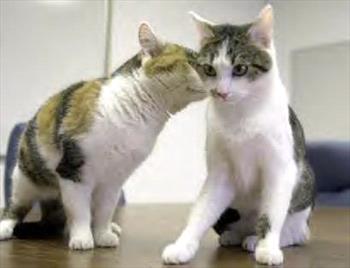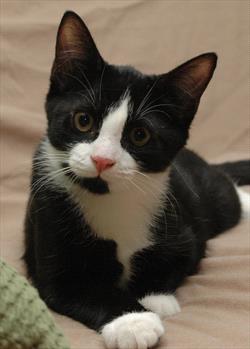Even with the most recent advances in veterinary medicine, your beloved cat won’t live forever, but is the next best thing just around the corner? Will it someday be possible to resurrect your cat with cloning?
Nearly a decade ago, on December 22, 2001, scientists at Texas A&M University announced the birth of CC, the world’s first cloned cat. CC, as in Copy Cat, has the same DNA blueprint as her genetic mother, Rainbow. So, like identical twins they share the same genetic code. That means everything’s the same—their looks, their mannerisms, their…. But wait.
A closer view in color reveals they don’t actually look identical. In fact, technically they’re not even the same color. Rainbow, with her spackling of orange mixed in with patches of black accentuated by a white belly and legs is calico while CC, who has no orange coloring at all, is a tiger-tabby. Is CC really a clone or is this another example of what some scientists call the Jurassic phenomenon?
Dr. Leslie Lyons, an associate professor of genetics at the UC Davis School of Veterinary Medicine was the first person with the answer back in 2001. “Texas A&M sent us samples blind to see whether the cells lines were identical,” says Lyons. “We were called upon because we have a large genetic database on the domestic cat.”
Lyons wasn’t told the cells were from a cloning project, but she promptly determined that the cell lines were identical and in doing so she confirmed that CC was indeed a clone of Rainbow (only CC is a clone).
Why Does This Clone Look Different
So why the difference in appearance? “The cool thing about CC,” said Lyons in that early interview, “is that it shows that even though two animals are genetically identical, they may not look or act identical. A clone is never actually identical because there are so many different environmental factors that come into play.”
The most obvious disparity here is coat color. The orange coat color gene in cats is peculiar in that it is randomly inactivated in some clusters of skin cells and activated in others. When activated, the skin cells produce orange fur and when inactivated they produce black fur. This process usually results in a mosaic of orange and black. In CC, the orange color gene was inactivated in all of the skin cells—thus no orange in her coat.
The white spotting pattern, which gives Rainbow and CC large white areas is also random. During fetal development, melanocytes, the pigment-producing cells in the skin, migrate across the skin starting from the back and racing towards the belly. If the melanocytes get a late start on their migration, they pull up short leaving the cat with flashy white ornamentation primarily on the underside and legs. This mechanism for expression of the white spotting gene means that even clones of say a simple black and white Sylvester-type cat would sport tuxedos with noticeable variations.
Of course the other clear physical difference between Rainbow and CC that you may have noticed in the photos is that Rainbow is a little tubby, and CC is trim and sleek. Exercise and nutrition also have a major effect on how individuals look.
Behavioral Differences May Be Even More Pronounced
It’s now almost ten years later, but even early on it was clear that physical appearance was just the start of the differences seen between Rainbow and CC. Personality is where one might expect the largest gaps to emerge, since a myriad of factors dramatically alter behavioral development. These influences start in the womb with factors as simple as nutrition. Kittens of undernourished mothers develop brain deficits leading to developmental delays in crawling, suckling, eye-opening, climbing, playing and predatory behavior. By four months these kittens show stunted learning ability and abnormal levels of fear and aggression.
Even within the same maternal environment, kittens can develop differently. Females born nestled between two males within the womb experience a testosterone bath which leads to masculinization of their brains. In dogs, where this effect has been studied, such females turn tomboy. Some lift their legs to urinate and develop a strong desire to sniff everything in their environment.
Once the youngsters are born, their environment becomes even more diverse and differences can quickly be amplified. As expected, social contact with the mother during the first four weeks is essential not just to survival, but also to normal emotional development. Those lacking this contact are unusually fearful of other cats and people and they exhibit randomly directed locomotor behavior. They’re also slow in the thinking department and show difficulty learning even simple associations such as the location of food sources.
Luckily some of these changes can be offset by early human handling. Early handling is also essential in prepping cats for life with humans. Kittens handled regularly as little as five minutes from birth to 45 days are friendlier to unfamiliar people and investigate new objects more readily than those that are not handled. This explains why feral cats that spend their early weeks hidden from humans are difficult to tame whereas those captured and raised with people early on make an easy transition to normal household life.
Even at several months of age, the difference in personality between CC and Rainbow were clear. Rainbow was reserved. CC had been handled a lot early on and was curious and outgoing. Her outgoing nature continues even now at 10 years of age. She was adopted by Duane Kraemer, a Texas A&M professor of veterinary medicine who helped clone her and who has been taking care of her since. She lives in a two-story cat mansion that overlooks the Kraemer residence. She had three kittens in 2006 the “natural way,” with her somewhat shyer mate, Smokey. According to the Kraemers, CC was a good mother. Both she and her offspring are neutered now since the mating was to determine whether a cloned domestic cat can reproduce.
Cloning Will Not Resurrect Your Pet
Texas A&M no longer works with the pet cloning company, Genetic Savings and Clone, that funded the research for CC. Consequently, your chances of ever having your pet cloned are slim. But even if the technology were available, the take home message with CC is that cloning will not resurrect your pet. Instead, you would be more likely to get something that looked similar to your beloved pet but that acted quite differently, or your clone could even end up looking like a complete stranger. Now that would be a dream, turned nightmare!




